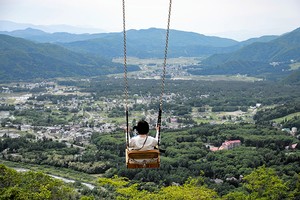By SATOSHI OKUMURA/ Staff Writer
November 23, 2024 at 07:00 JST
Set to detonate about an hour to a week after impact, a bomb dropped in the later stages of World War II didn't explode for nearly 80 years at Miyazaki Airport in Miyazaki.
The bomb that created a crater on the former military airfield taxiway when it exploded underground on Oct. 2 was a delayed detonation bomb dropped by U.S. forces, according to the Defense Ministry.
In addition, many other similar cases previously confirmed in Japan also involved bombs fitted with time-delay fuses.
WHY THE DELAY IN DETONATION?
Many delayed detonation bombs dropped on Japan by U.S. forces during the war were set to explode between an hour to six days after hitting the ground.
When such a bomb is dropped, the wind pressure causes the propellers attached on the bottom to spin and break a glass container filled with corrosive liquid.
The liquid then starts melting a celluloid material used as part of the stopper, leading to detonation after a certain period of time depending on the thickness of the celluloid and other factors.

"Bombs with ordinary fuses won't explode unless they are subjected to a substantial impact, but unexploded time bombs are unstable because their triggers are supported by small parts," said Tatsuya Yamamoto, a member of a civic group founded to keep records of air raids and war damage who is also well-versed in bombs.
It is also possible that unexploded bombs can be detonated when the glass container is broken due to vibration or other factors, or when the celluloid material and other parts deteriorate over time.
DROPPED IN TOKYO, KYUSHU
According to a Tokyo-based association specializing in detecting unexploded ordnance, there have been about 20 cases of spontaneous unexpected bomb detonations after the war mainly in the Kyushu region and western Tokyo.
Tsuyoshi Tanaka, head of the geological survey division at Nippon Geophysical Prospecting Co., which is also based in Tokyo and conducts searches of unexploded ordnance, said it is possible that time-delay fuses were responsible for spontaneous detonations.
"There are no such cases in Osaka, Nagoya and elsewhere where many bombs were dropped, while they occurred in places where bombs with time-delay fuses were dropped," he said.
Areas where time-delayed bombs were dropped were closely associated with the purpose of using them.
In western Tokyo, they were used on three occasions during air raids targeting military plane factories in April 1945.
Time-delayed bombs were used to delay the detonation to prevent smoke from the explosions from blanketing the areas and help follow-up attackers strike their targets.
Of about 20 spontaneous explosions that occurred, nine occurred in western Tokyo and the surrounding areas between 1946 and 1982.
HELPING OPERATIONS IN OKINAWA
In the Kyushu region, U.S. forces primarily targeted airfields operated by imperial forces to support their operations in Okinawa Prefecture, according to records of air raids conducted by B-29s.
After U.S. forces landed on Okinawa's main island in April 1945, they suffered heavy damage from kamikaze suicide air attacks.
The U.S. forces decided to use time bombs to incapacitate airfields in the Kyushu region from which pilots flew suicide missions.
After bombs were dropped on the airfields, they penetrated to deep underground and there was no way of telling when they would detonate.
They caused repair work to be delayed, while the runways were destroyed again when the bombs exploded after repairs were made in some cases.
According to U.S. military documents, they achieved major results with the bombings on the airfields and their facilities in Kyushu.
The U.S. military said the bombardments with time-delay bombs tormented the Japanese forces and prevented them from making the region a staging point to counter their campaigns in Okinawa.
Bombing targets were also expanded to include an airfield in Matsuyama and other facilities in the southern and western parts of the Shikoku region.
The documents also show that 250-kilogram bombs armed with a time-delay fuse were dropped on Miyazaki Airport's predecessor, which was an Imperial Japan Navy airfield.
Spontaneous unexploded bomb detonations had been confirmed across Kyushu, including Saiki in Oita Prefecture in 1969, Oita in 1992 and 1994, Hyuga in Miyazaki Prefecture in 1967, 1972 and 1975 and Kirishima in Kagoshima Prefecture in 1996.
Each city was home to an airfield or a plane factory run by imperial forces, repeatedly targeted in air raids with time-delayed bombs.

Meanwhile, no U.S. military records have been found to say time-delayed ordnance was dropped on Okinawa's main island.
Each year, about 500 cases involving unexploded bombs are handled in the prefecture, where the largest ground battle took place during the war.
But there has been only one case of spontaneous detonation, which was confirmed in Nishihara in 1981.
The municipality's public relations magazine released at the time said that a mortar shell found at a construction site was left abandoned and spontaneously combusted after yellow phosphorus inside it came in contact with air.
"When unexploded bombs fitted with time-delay fuses are thought to remain near airports and other important infrastructure, I think the central government should proactively conduct surveys," Yamamoto said.
He added: "Caution is required when it comes to dealing not only with unexploded ordnance with time-delay fuses but also with all the other bombs because there is a possibility that explosive charges have deteriorated and have become easier to ignite."




















A peek through the music industry’s curtain at the producers who harnessed social media to help their idols go global.
A series based on diplomatic documents declassified by Japan’s Foreign Ministry
Here is a collection of first-hand accounts by “hibakusha” atomic bomb survivors.
Cooking experts, chefs and others involved in the field of food introduce their special recipes intertwined with their paths in life.
A series about Japanese-Americans and their memories of World War II